VOLKSWAGEN GOLF PLUS 2004 Owners Manual
Manufacturer: VOLKSWAGEN, Model Year: 2004, Model line: GOLF PLUS, Model: VOLKSWAGEN GOLF PLUS 2004Pages: 541, PDF Size: 98.86 MB
Page 201 of 541
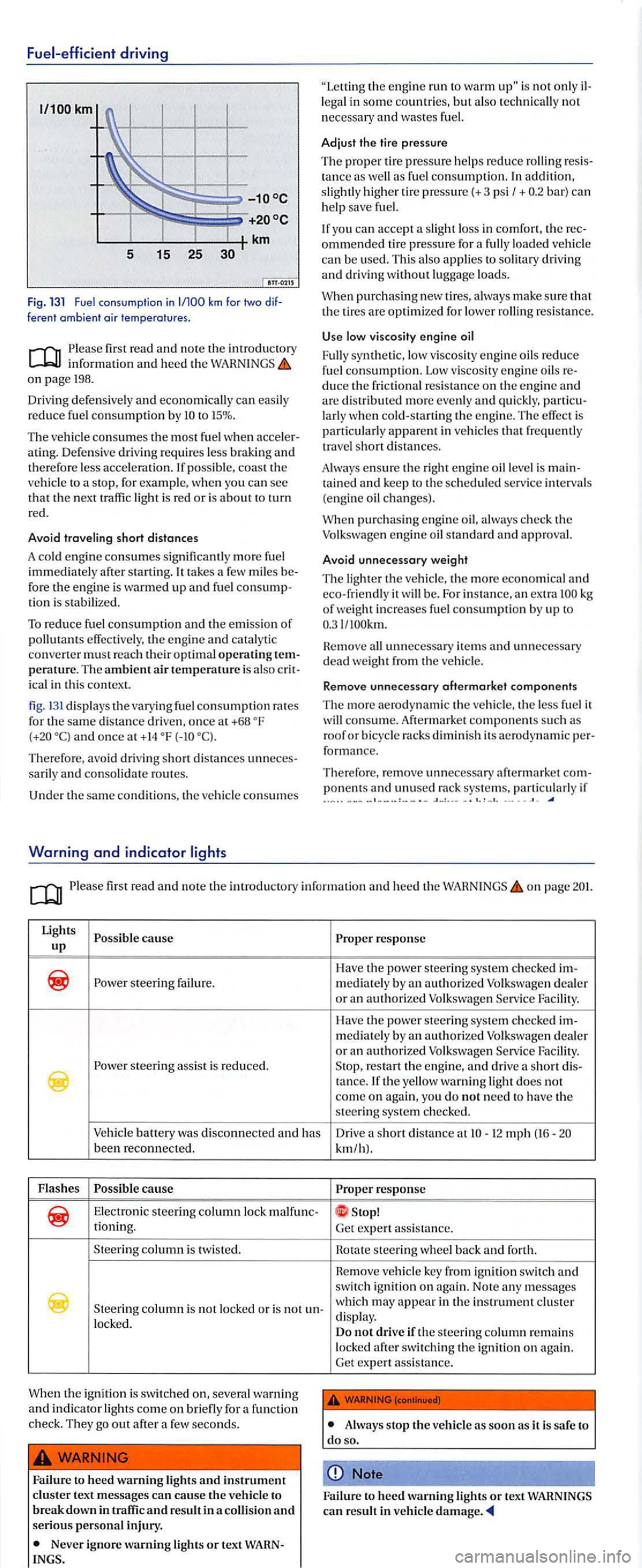
Fuel-efficient driving
Fig. 131 Fuel consumption in ferent ambient air temperatures .
info rmation and heed the on page 198.
Dri vin g defensive ly and economically can easily
r educe fuel con sumption by to 15 % .
The ve hicle consu mes the most fu el w he n atin g. D efe nsive dri vin g require s less brakin g and therefore less accelerat ion. If possib le, coast the ve hicle to a sto p, for exa mple, when yo u ca n see th a t th e next traffic ligh t is red or is about to turn
red.
Avoid traveling short distanc
es
A cold engine consumes sig nificantl y more fuel
imm ediately after sta rtin g. It take s a few miles fore the engi ne is warm ed up and fuel tion i s stabili zed.
To reduce fuel consumptio n and the emission of pollutants effect ive ly, the e ng in e and ca talytic
conve rter must reach th eir optimal operating
ica l in thi s context.
fig. 13 1 displays the v a ry ing fuel consumption rates
for the same d istance dri ven, once at +68 and once at + 14
th e e ngin e run to warm is not o nl y lega l in some co untries, but also technicall y not
n ecessary and wastes fu el.
Adjust the tire pres sure
T he prop er tir e
pressure help s reduce rollin g tance as well as fue l co nsumption. In additi on ,
slig htl y higher tire pressure(+ 3 psi I+ bar) ca n
h e lp save fuel.
If you ca n a ccept a slight los s in comfort, the ommend ed tir e pressure for a fully loade d ve hicl e
ca n be used. This als o applies to so litary dri vin g and driv ing withou t lu ggage loa ds.
When purchasing new t ires, alway s ma ke sure th at
th e tires are optimi zed for lower rollin g resis tance.
Us e low viscosity engine oil
F ull y sy nth e
tic, low viscosity e ngine oils reduce
fuel consumption. Low viscosity e ngin e oils duce the fric tional res istance on th e engine and are dis tributed m ore evenly and qui ckly, larly w hen co ld -s tarting the engine. The effect is parti c ularl y apparent in vehicles th at frequentl y
tra vel s hort dis tan ces.
A lways ens
ure th e righ t e n g in e oil leve l is ta in ed and keep to the sc h edul ed serv ice interva ls
(e ng ine oil ch an ges).
W
hen purch asing e ngine oil, always ch eck th e Volksw agen en gine oil standard and approval.
Avoid unnecessary weight
The lighter th e ve hicl e, th e more economica l and ceo-friend ly it w ill be. For in stance, an extra
H e m ove
consum e. Aftermark et co mponents s uch as
ro of or b icycle racks dimin is h its aerod yn a m ic fonnan ce.
Th erefo re, re
mov e un necessary aftermark e t ponents and unused rac k systems, parti cul arly if ....... -
fir st read and note th e introductory informa tion and h ee d th e WAHNINGS page
response
Ha ve the power stee rin g sys te m ch ec ked ste eri ng failure. mediatel y by an authori zed Volk swag en deale r
o r a n authorized Volk swagen
Fac ility. steeri ng ass is t i s reduced. re start the e n gine, and dri ve a sh ort tan ce. If th e yello w warning light does not
c o m e on again, you do not need to have th e
s te ering syste m ch ec ke d .
Vehicle battery was di sconnected and has Drive a short distan ce at 12 mph been reconnec te d . km/h).
F lashes re sponse
Elec troni c steering column lo ck malfunc -
which m ay appea r in the in strument clu ste r
di sp lay. loc ke d.
W
hen the i g nit ion is switc h ed on, seve ra l wa rnin g and indicator lights come on bri efly for a f un ction ch e ck . T hey go out after a few seconds.
Failure to
heed warning light s and in strument cluster text m essages can cause th e vehicl e to break down in t raffic and result in a collisio n and seriou s personal injury.
Neve r igno re warning lights or tex t
Do not dri ve if th e s teerin g co lumn remains
l ocke d switch in g th e ig niti on on aga in.
Ge t expert assis ta nce.
Alwa ys sto p the vehicl e as soon as it is safe to do so .
Note
Failur e to heed warning lights or tex t WARNINGS can res ult in vehicl e damage
Page 202 of 541
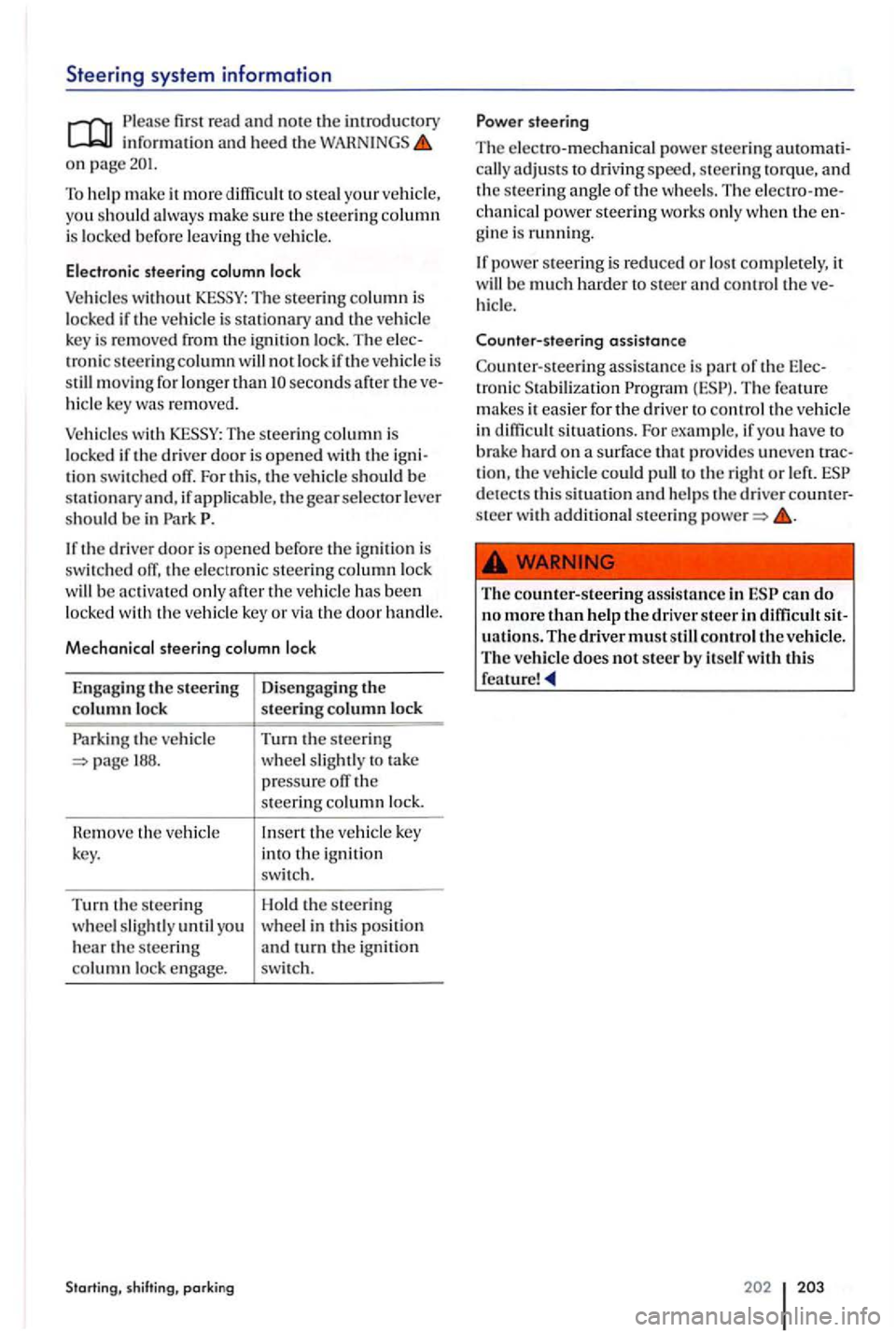
Steering system information
first read and note the introductory informatio n and heed the on page
To help m ake it more diffi cult to s teal your ve hicl e,
you sh ould always make sur e the steering co lumn is locked before leaving the ve hicle .
Electronic steering column lock
Vehicles with o
ut The s teering column is
l ocked if the vehicle is stationary and the vehicle
k ey is removed from the ign ition lock. The elec
tr onic s teering column will not lock if the vehicl e is
s till mov in g for longe r than seconds after the ve
hicl e key was re moved.
Vehicles with
Th e s teering column is
l ocked if the dri ver door is ope ned with the ignitio n switch ed ofT. For this, the ve hicle should be
s tationary if applic abl e, the gear selector leve r
s h ould be in
If the driver door is opened befo re the ign ition is
sw itch ed
188.
H e
move th e ve hicl e
k ey.
Turn th e s teering
w heel s lig htl y until you
hear the steering
column l oc k en gage.
Starting, shifting , parking
Disengaging the
steering column lock
Turn the s teering
whee l s lightl y to take pressure ofT the
s teerin g column lock.
In
sert the ve hicl e key
into the ignition swit ch .
Ho ld th e s teerin g
wheel in thi s pos ition
and turn the ignition switch.
steering
The e lectro-mechanical power steering auto m ati
c ally adjusts to dri ving speed, steering torque , and the steering angle of the wheels . The e lectro-me
c hanical power steering work s only w hen the en
gine is running.
If power steering is reduced or lost comple tely, it
will b e much harder to steer and co ntrol the ve
hicl e.
Counter-steering
assistance
T he feature
m akes it easier for the dri ver to control the vehicle
in difficult situation s. For exampl e, if yo u h ave to
brak e h
ard on a surface that provides uneve n t rac
tion, the ve hicle could pull to the right or l eft. detect s th is situation and h elps th e dri ver counter
s teer with additi onal steerin g
The counter-steering ass istance In
Page 203 of 541
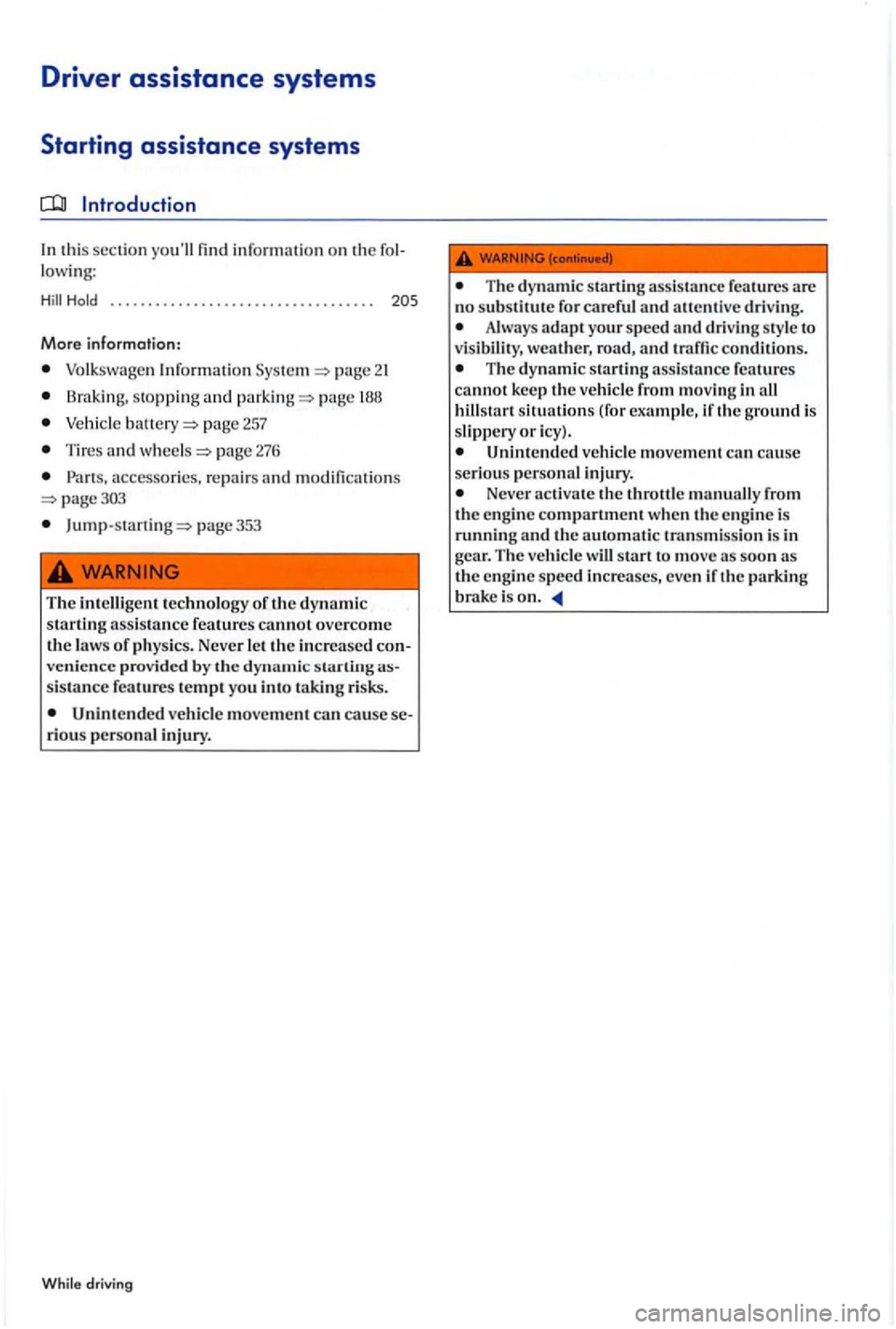
Driver assistance systems
Starting assistance systems
Introduction
In thi s section find informatio n on th e lowing :
. . . . . . . . . . . . . . . . . . . . . . . . . . . . . . . . . . .
More informat ion:
Volkswagen Info rmation page 21
Brak ing, s topping and
Vehicl e page 257
Tires and
accesso ries, repairs and modifica tions page 303
p age 353
The intelligent technolo gy of the dynamic starting assis ta nce features cannot overcome t11e laws of physics. Never let th e increa se d
Uni ntended veh icle move ment ca n cause rious personal inju ry.
driving
The dynamic s tarting assistance f eatures are no s ub stitute for carefu l and att ent ive driving. Alwa ys adapt your sp ee d and driving s tyle to
v isi bilit y, weather, ro ad, and condition s. The dynamic start ing assistance features can not keep the vehicl e fro m moving in all hillstart situations (fo r exa mple, if the ground is
s lippe ry or icy). Unint ended vehicle movement ca n cause seriou s personal injury. Neve r activate the throttle m anually from the e ngine compartment whe n the e ngin e is running and th e automatic tra nsmission is in gea r. T he vehicle will start to m ove as soo n as the en gine speed in creases , eve n if th e brake is o n.
Page 204 of 541
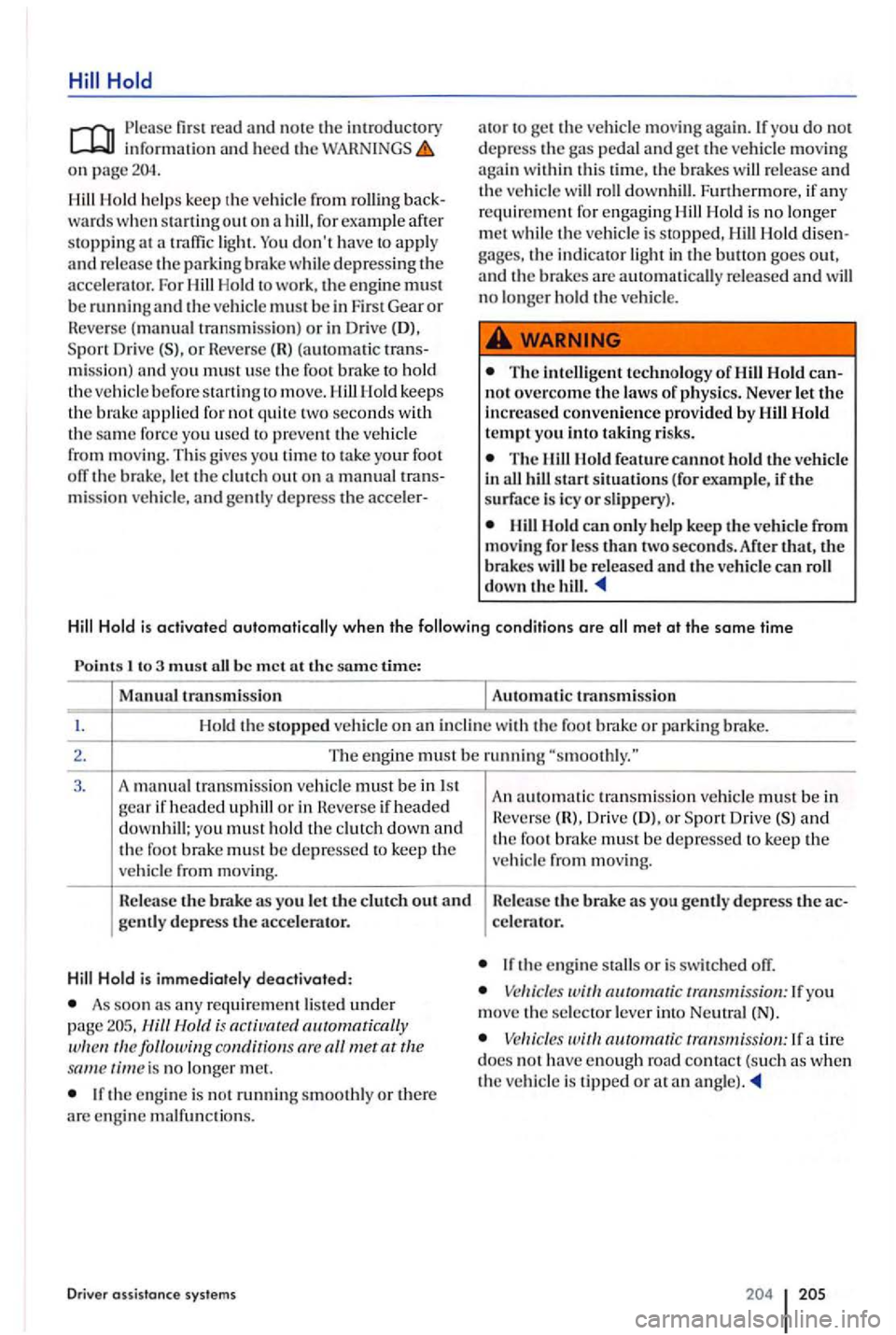
first r ead and n ote th e introducto ry in forma ti o n o n page
Hill Hold help s keep th e vehicl e from rollin g back
w ard s w hen sta rtin g out on a hill , for example aft er
s topping at a lig h l. don 't h ave to appl y
and r e le ase the parkin g brak e whi le dep re ss in g the For Hill Hold to work . th e e ng in e m ust
b e runni ng and the veh icle mus t b e in First Gea r or R eve rse (m anual tran smissio n) o r in Driv e (DJ. Dri ve (S), o r Reve rse (R) (a utomatic trans
mi ssion) and yo u must usc the foo t b ra ke to ho ld
th e ve hi cle befo re
force yo u u sed to pre ve nt the ve hicl e
from moving. This g ives you tim e to take your foo t
off the brake, le t t h e clu tc h out on a m anual t ran s
m ission ve hicle . and gently depress the acc ele r- a
to r to
p edal and ge t the ve hicl e moving
a ga in w ithin this time, the brake s will and the ve hicle will roll downhill. Furtherm ore , if re qu ire m en t f or e nga gin g Hill Hold is no lo nge r
m et while the vehicle is s toppe d, Hill Hold di sengages, the in dicator light in the butto n goes out,
a nd the brakes are automatically re leased and will no lo nge r h old the ve hicl e.
The intelligent technolo gy of
The llillllold feature cannot h old the ve hicl e
in all start situ ations ( for example, if the
surface is icy or s lip pery ).
Ho ld can only help keep the ve hicl e from mov ing fo r l ess than two seconds. Af te r tha t, the
b rakes be re lease d and the ve hicl e can roll
d ow n the hill .
Hill Hold is activated outomoli colly when the following conditions ore all met at the some tim e
I to 3 mus t b e m et a t the sa m e time:
M
anua l tran smissio n Automatic transmission
H old the stoppe d ve hicle on a n in cline w ith th e foot brake o r park in g brak e.
2.
3.
The e ngine must be run ning
if uphill o r in Revers e if headed
d o w nhill; you must hold th e clutch down and the foo t brak e must b e d ep ressed to keep th e
ve hicle from mo ving.
R elease the brake as yo u let the clutch out an d
g e ntl y de press the accelerator.
Hill Hold is imm ediat ely deactivated :
As soon an y re qu ire m en t liste d unde r page is a cti ua te d auto matically follo win g con d itio ns ar e time is no longe r m el.
If the engin e is not runnin g smoothl y or there
a rc e ng in e malfun ctions.
D river assista nce systems
A n autom atic transmissio n ve hicle must b e in
H e vc rse (R). Dr iv e (D ), or S po rt Drive ( S) and th e foot brak e m ust be d epresse d to keep the
ve hicle from movin g.
R el
ease the brake as yo u gentl y depress t11e celc rnt or.
If th e e ng in e s tall s or is swi t c he d off.
Vehicles ruitl1 automatic If you m ove the selector lever i nt o N eutral (N).
Vehicl es autom ati c tran smission: If a tir e docs no t h ave eno ug h ro ad contac t (s uch as w hen the ve hicle is tippe d or at an
Page 205 of 541
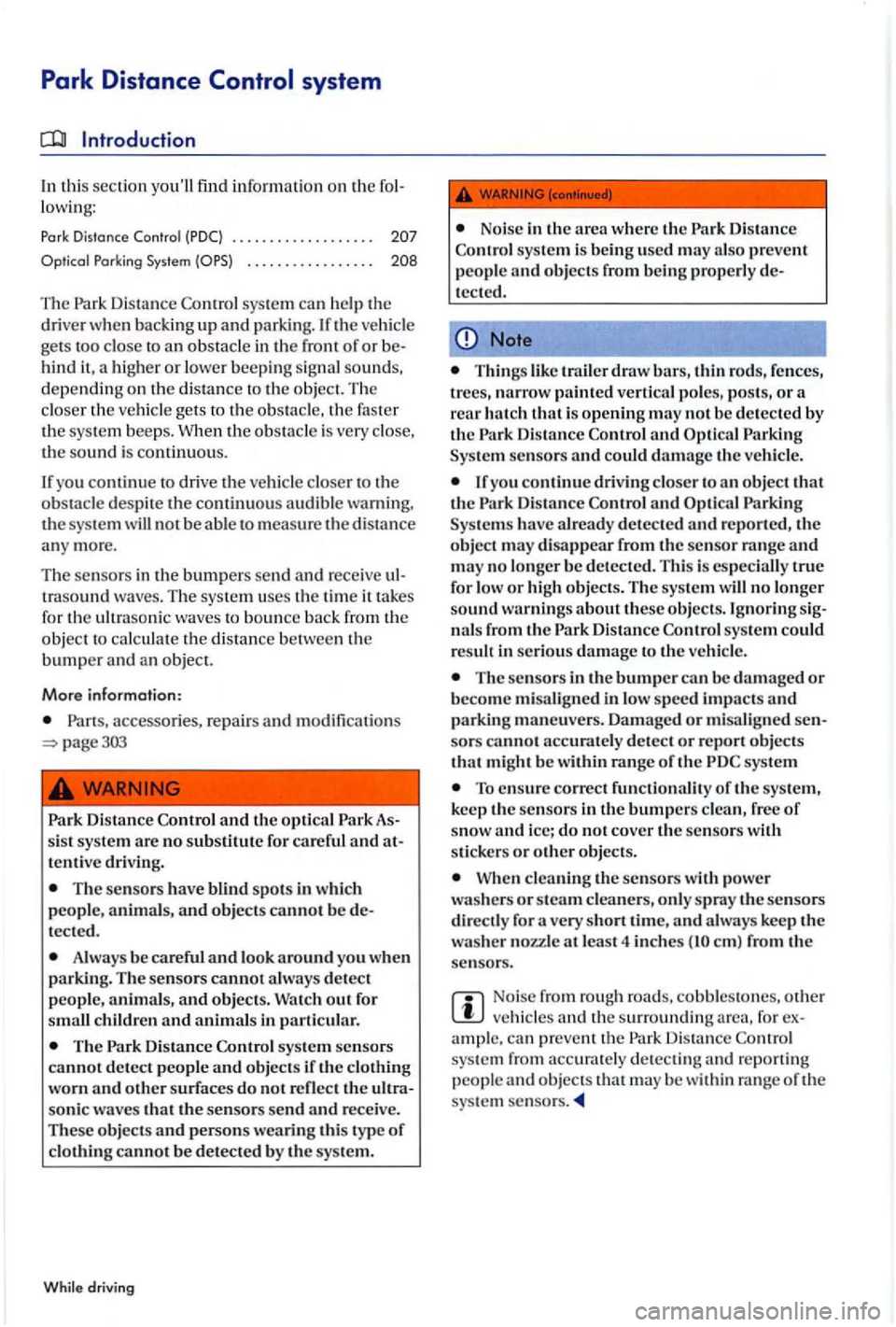
Park Distance
Introduction
In this section you'll find on the lowing :
Pork Distanc e Control (PDC) . . . . . . . . . . . . . . . . . . .
. . . . . . . . . . . . . . . .
The Park Dis tance sys te m can help the
dri ver w hen backi ng up and parking. If the vehicle
gets too close to an obstacl e in the of or hind
trasound waves. The sys te m u ses the tim e it ta kes for the ultra sonic w aves to bo un ce back from the
object to ca lc ul ate the distance between th e bumper and an object.
More information:
Parts, accessories, repairs and modifications
and th e optical
tentiv e driving.
The sensors have blind spots in which
peopl e , animals, and objects cannot be tected.
Always be careful and look around you when
parking. The sensors cannot alwa ys detect
p eo ple, a nimals , and objects . W atc h out for small children and animals in parti cular .
The sys te m sensors cannot d etect p eople and obj ects if th e clothing worn and other surfaces do not reflect the sonic waves that the sensors send and rece ive .
These objects and persons wearing this type of clothing cannot be detected by the sys tem.
While driving
Noise in the area where the Distance sys tem is being used may also prevent
peopl e and objects from being properly tecte d .
Note
T hing s lik e trailer draw bars, thin rods, fences, tree s, narrow painted vertical poles, pos ts , or a rear hatch th at is opening may not be detected by the and Opti cal Sys te m sensors and co uld damage the ve hicl e.
If you continue drivin g closer to an object that
th e
Systems have already detec te d and reported , the obj ec t may di sappear from the se nso r rang e and may no longer be detecte d . This is es pecially true for low or hi gh object s. The system will no longer
sound warnings about these objects. Ignoring nals from the sys tem could res ult in seriou s dama ge to th e ve hicl e.
The sensors in the bumper ca n be damaged or be co me mi salig ned in low spee d im pacts and parking maneuv ers. Damag ed or mi saligned
T o ensure correct functionality of the sys te m ,
keep the se nsors in the bumpers c lean, free of snow and icc; do not cover the se nsors with
s tickers or o th er objects .
When cleaning the senso rs with power
washer s or steam clean ers, only spray the sensors
d ire ctly for a very short time, and alway s keep the
washer nozz le at least 4 inches em) from the sensors.
Noise from rough roads, cobb les tones, other ve hicl es and the surr ounding for ample, ca n p reve nt th e Park Dis ta nce sys te m fro m acc urate ly detecting and report ing
p eople and objec ts that be w ithin range of th e
sys te m se nso rs.
Page 206 of 541
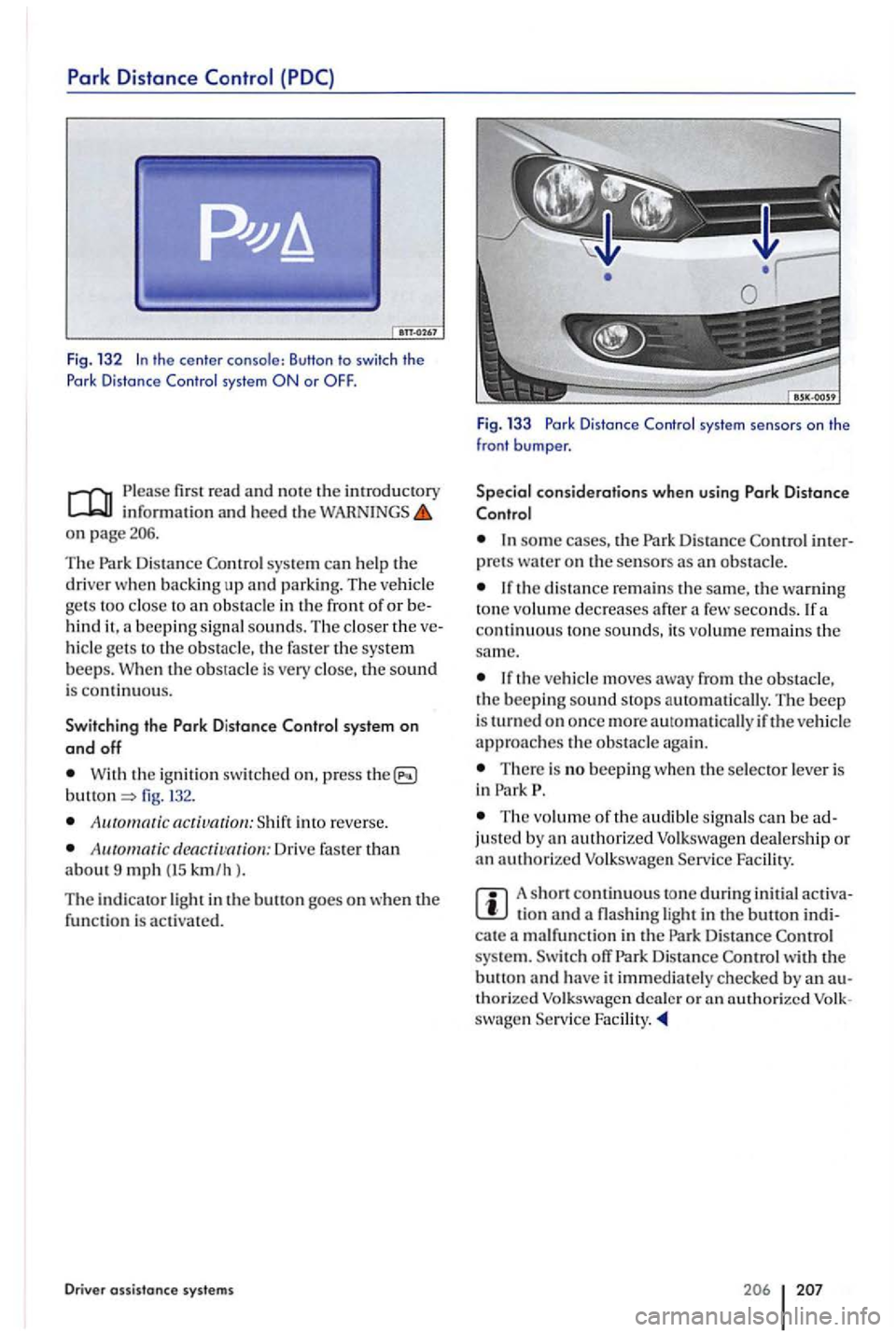
Park Distance (PDC)
Fig. 13 2 the center console: Button to switch th e
P ork Distance Control system
Please first read and note the introductory information and heed the on page
system can help the driver when backing up and parking. The ve hicle
ge ts too close to an obstacle in th e front of or behind it , a beeping sig nal sounds. Th e closer the ve
hicl e gets to the obstacle, the faster the system beeps. W hen the obstacle is very clo se, the sound is conti n uous.
Switch in g the D istance Contr ol sys te m on
a
nd off
W ith the ignit ion switc hed on, press the fig. 132.
A u into reverse .
denctivatiou: Drive faster than about 9 mph (15 km/h ).
T he indi cator
light in the button goes on
Distance Control
some the Park Distance Control interpret s wa te r o n the sensors as an obstacle.
I f th e dista nce remains the same, the warnin g
ton e volume decreases after a
There is no beeping when the selector lever is
in Park P.
The vo lume of the audib le s ig n als can be ad
justed by an authorized Volk swage n dealership or an authorized Volkswagen Service Facility.
A short continuous tone during initi al activation and a light in the button indicate a malfunction in the Park Distance system. Switch off Park Distance Control w ith the button and have it immediate ly checked by an au
thori zed Volkswagen deale r or
Page 207 of 541

detec te d in segment. @ a re o b ehind t he
firs t read and no te the introductory inform ation and heed the on page206.
Th e
Parking System is an enhancem ent of th e Park Distance page 207.
Functio n
Fig . 1 3 5
The area s scanned b y th e sensors in fron t of and
b e hind the veh icle are disp la yed in the screen of the facto ry-install ed sound sys te m or navigation
sys te m . obstacles are
p age 207-. is autom atically
a c tiva te d .
an area se le ct io n bu tto n on th e factory-ins talled rad io o r navi-
Manuall y deactiva te dis play: gat ion sys te m.
o n To uch the fu nct io n butto n on th e screen.
Drive
fas te r than 6-9 mph (10-15 km/h) . Automatic ally deactivate dis pl ay: ve hicle s w ith Hear Assis t, s hift into page 210 . The p lay swi tc hes to th e ima ge.
Scanned areas
The obsta cl e detection area exte nds up to about 4
f t. (120 em) in front of the ve hicle and up to about 2
ft. (60 em) to e ither fig. 135 a rea hind th e ve hicl e is scanned u p to a dis ta nce of about 5 ft. (160 em ) and about 2ft. (60 em ) to either
Screen display
T he dis p lay sh ows the scanned area in seve ra l m ent s. The closer th e ve hicl e ge ts to th e obstacl e,
th e closer the segm ent m ove s toward s the ve hicle
i n th e fig. 13 4 135 the nex t- to -la st segm ent is dis p laye d, the
collis io n zone has be en reac hed. Sto p!
Di s
tance be twe en vehicl e and obstacl e Audible signal For color disp lay s: Seg ment color if an obstacle is detected
F ront: fr o m about l ft. (3 1 em) to 4 ft.
( 1 20cm)
Beep Ye llow
Rear : fro m about l ft. (31 em) to 5 ft. (160 em)
From about 0 ft. tone Hed or
While driving
Page 208 of 541
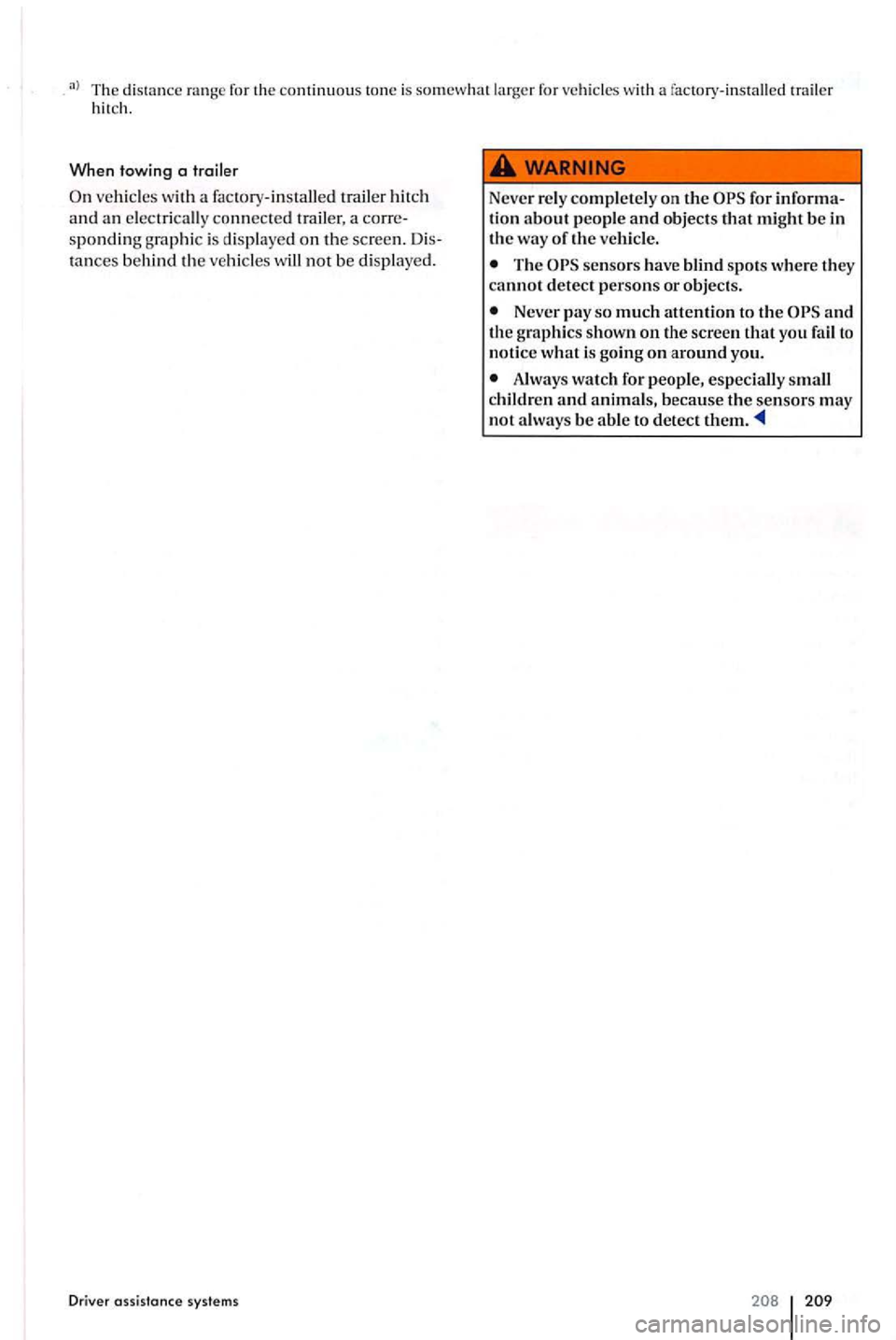
The
vehicl es with a factory-installed trailer hitch
a nd an elec trically co nn ected a corre
s p ondin g grap hic is displayed on th e sc reen. Dis
tan ces behind the vehicl es will not be displayed.
Drive r assis tance systems
Never rely completely on the
The sensors have blind spots where they
cannot detect persons or objects.
Never pay so much attention to the and the graph ics shown on the screen that you fail to notice what is go ing on around you.
Always watch for people, especially s mall
children and animals, because tl1e sensors may
not always be able to detect t11em.
208 209
Page 209 of 541
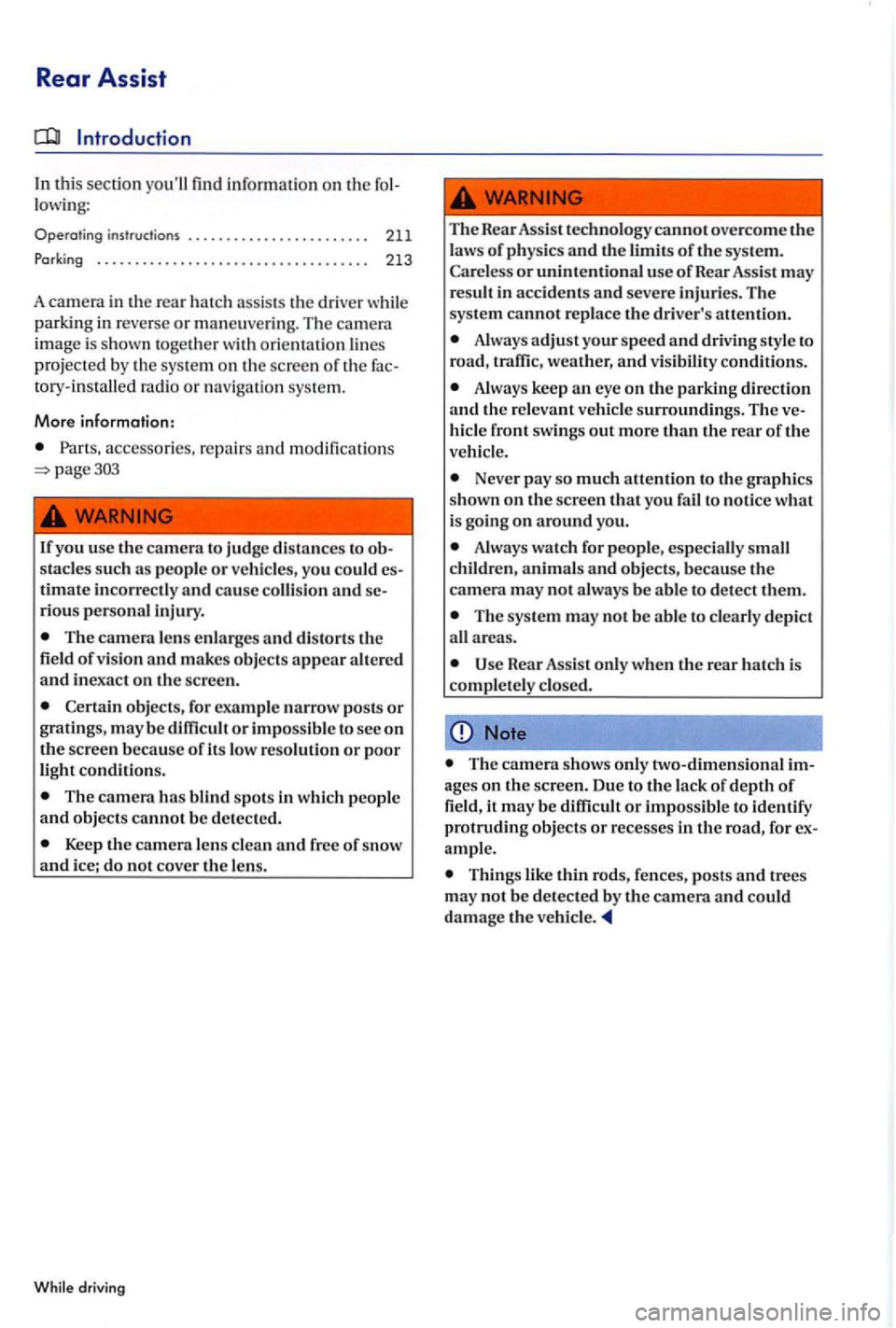
Rear Assist
In thi s sec tion you'll find on th e lowing :
Operating instru ctions . . . .. . . . .. . . . .. . . . . . . .. . 211
Par king . . . . . . . . . . . . . . . . . . . . . . . . . . . . . . . . . . . .
213
A camera in the rear hat ch assis ts th e driver parkin g in reve rse or maneu ve ring. Th e ca mera
image i s s how n with orientati on lines proj ecte d by th e sys te m on th e screen of th e tory-in stall ed radio or na vigatio n sys tem .
More information:
Parts, accessories, repai rs and modifi cation s
If you use the ca mera to judge distances to stacles such as people or vehicles, you could timate inc orre ctl y and cause colli sion and riou s personal injury.
The camera lens enlarg es and distort s th e
field of vision and makes object s appear altered and in exact on the screen.
C ertain objects , for exa mpl e narrow posts or gratings , m ay be diffi cult or impo ssible to see on the scree n becaus e of its low resolution or poor light condition s.
The camera has blind spots in which people and objects cannot be dete cted .
Keep the camera len s clean and fr ee of snow and ice; do not cove r the le n s.
driving
The Rear Assist technology cannot overcome the law s of physics and the limit s of the system. Care less or unintentional use of Rear Assist may
re sult in accidents and seve re injuri es. The
sys te m ca
nnot repla ce the driver's attention.
Always adjust your speed and dri ving style to
road, traffic , weather, and visibility conditions.
Always keep an eye on the parking direction and the relevant vehicl e surrounding s. The
Never pay so much attention to the graphics
s hown on th e screen that yo u fail to notic e what is going on around you.
Always watch for peop le, especi ally small
children, animals and o bject s, because the cam era may not a lways be able to detect the m .
The sys tem may not be able to clearly depict
all areas.
Use Rear Ass is t only when the rear hatch is
completely closed.
Note
The camera shows only two-dimensiona l ages on the scree n. Du e to the lack of depth of field, it may be diffi cult or impossible to identify
protrudin g object s or recesses in the road, for ample.
Thing s lik e thin rods, fence s, pos ts and t rees may not be dete cted by the cam era and co uld damage the vehicle.
Page 210 of 541
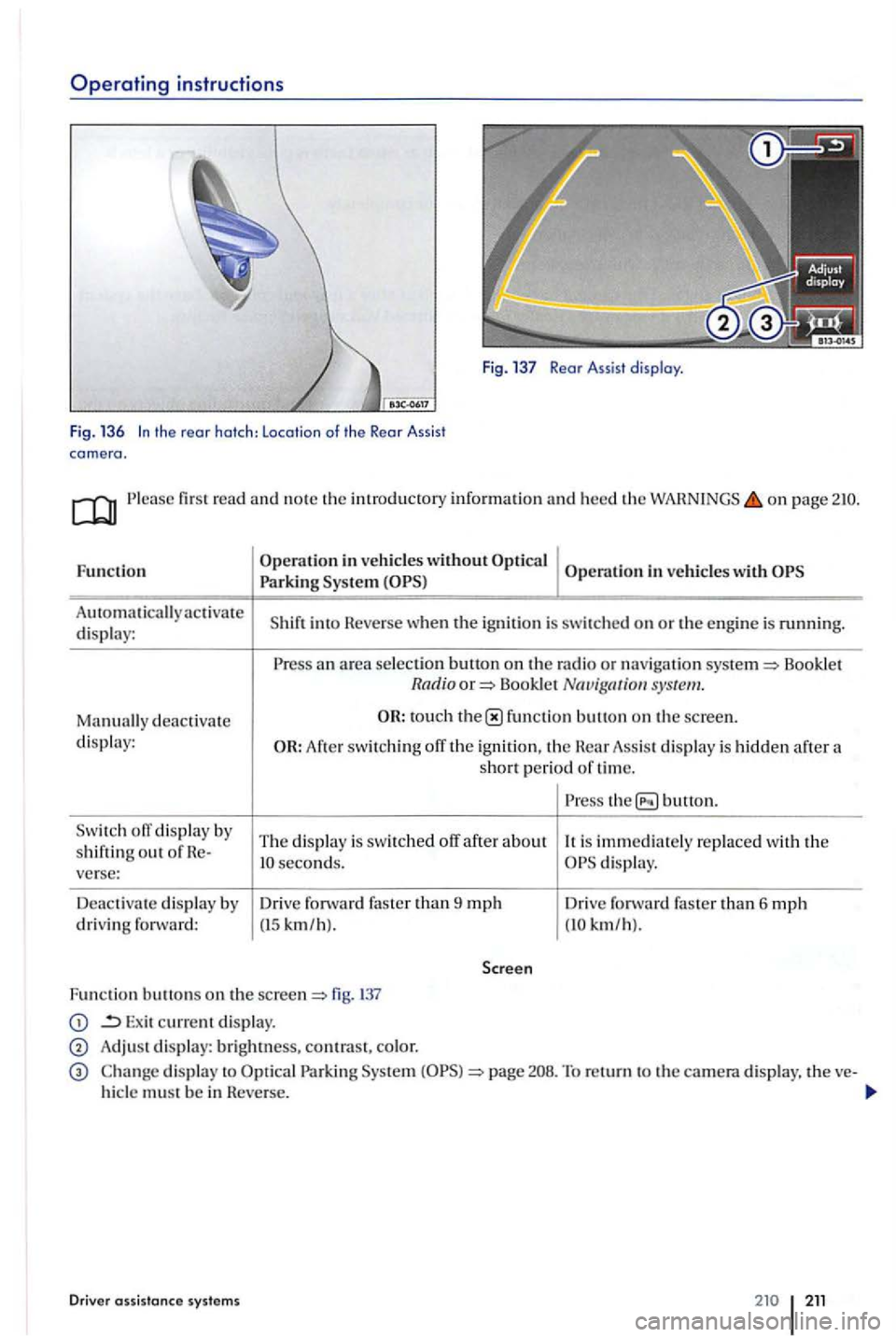
Operating instructions
Fig. 137 Rear Assist display.
Fig. 136
fir st read and note th e introd uc to ry info rmation an d heed the on page
Fu nc tion
A
uto mati cally display:
Man uall y dea c tivate dis p la y:
ofT d is p la y by
s h if tin g o ut of verse:
D ea c tiv a te di spla y by
d riv in g fo rward:
. . h Pa rk in g System ve uc es wtt
R eve rse whe n the ignition is sw itch ed on or the engine is running.
a n area se lection button o n the rad io or n av igation Book let Radio Book let syste m .
Afte r switc h in g off the ignition, th e Hear Assis t di spl ay is hidden aft e r a short period of ti m e.
T he di splay is
swit ch ed off after about seconds.
Driv e f
orward faste r than 9 mph (15 km /h ).
button.
is immediately re p lace d with the di sp lay.
Dri ve fo rward fas te r than 6 mph km/h ).
Fun c
tion bu tto ns o n the fig.
Exit current display.
Adjust dis p lay: brightness, contra st, color.
di sp la y to Park in g To return to the camera d is p la y, t he hicl e m ust b e in Heve rse.
Drive r syst ems 211